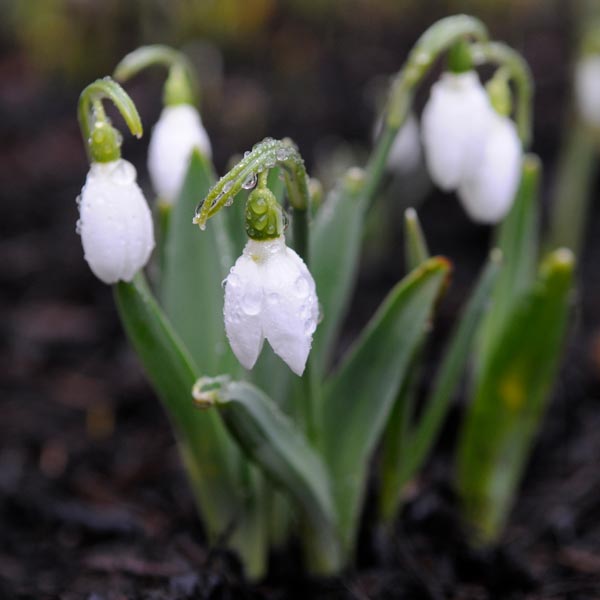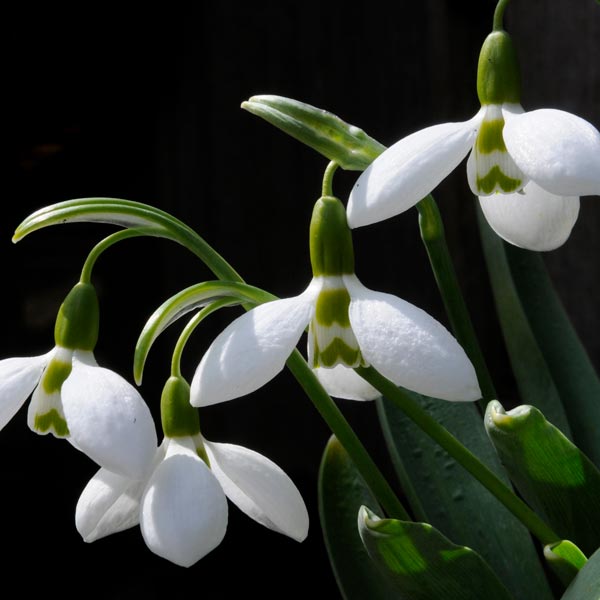

Snowdrops
Galanthus spp.
The Snowflake Fairy
Robed in white comes Snowflake Fairy, braving wintry winds and ice, pearly "Maid of February," whom the glistening frosts entice. Gladly welcome Snowflake Fairy, on your terrace give her room. She alone in February braves the cold to shed her bloom.
—Elizabeth Gordon


What can give us more hope that the end of winter is near than to see the young shoots of snowdrops (Galanthus spp.) emerging from the frost-covered ground? We can be well assured that spring is just around the corner by the very sight of their blooms standing out against the melting snow or brown earth. Often the first bulbs to bloom, snowdrops are not only beautiful, but easy to grow.
Snowdrops are in the amaryllis family (Amaryllidaceae), and there are only a dozen cultivated species, mostly native to the deciduous woodlands of Europe and western Asia. Snowdrops are often confused with snowflakes (Leucojum spp.), to which they are closely related. Snowflakes are not only later-blooming but also much larger. Although both plants have white, bell-like flowers with green-tipped segments, the snowdrop has green tips only on the inner flower segments; the three larger outer segments are unmarked.
Woodland settings are ideal for snowdrops, and they will return year after year if given winter low temperatures that reach at least 20 degrees Fahrenheit, but no colder than 30 degrees below zero. Snowdrops are equally effective whether they are naturalized in large masses, tucked in small pockets in rock gardens, or grown in colonies under early spring-flowering shrubs.
Snowdrops can be easily forced indoors as well. In the fall, plant four bulbs 1 inch deep in a 4-inch pot. Put the pots in a cold frame, unheated greenhouse, or refrigerator, where the temperature range is between 35 and 43 degrees. Approximately 10 to 12 weeks later, check to see if buds have developed. If so, bring them into a cool, bright indoor spot, making sure the compost does not dry out.
For outdoor displays, plant bulbs as soon as they are available in the fall. Place in a sunny or semi-shady site, in moist soil with a large proportion of humus. The site should be well drained, with a neutral to alkaline pH level. Set bulbs 3 to 4 inches deep and 2 to 3 inches apart, or scatter them for a more naturalized look. Water regularly when they are in bloom. Little fertilizing is needed. When flowering has finished, let the leaves dies back naturally. The leaves continue to produce food for next season's bulbs.
Snowdrop bulbs can remain undisturbed for many years and will multiply by themselves; however, they also can be propagated by division. The best time to move or divide snowdrops is when they have just finished flowering. Lift the bulbs and the soil around them so as not to disturb the roots, and replant immediately in sections of no fewer than four or five bulbs. Be sure the newly transplanted bulbs receive a thorough watering.
The following two species are the most readily available from retail outlets, and there are fine displays of these in the Graham Bulb Garden at the Chicago Botanic Garden:
Common snowdrop (Galanthus nivalis)
This species has 1/4-inch, blue-green leaves and 6- to 9-inch stems that support a single flower, 1 inch in diameter. Flowering from January to March, the common snowdrop blooms slightly earlier than the giant snowdrop. Native to almost all of Europe, it can be found growing in woods and by streams. Among the choicest varieties are 'Atkinsii', which is very early blooming, and 'Flore Pleno', which is double-flowered.
Giant snowdrop (Galanthus elwesii)
As its common name implies, this species has relatively large flowers that are 1 1/2 inches long and borne singularly on 6- to 12-inch long stems. The basal leaves are 8 inches long and 3/4-inch wide. Flowering from February to April, this species withstands hot weather better than G. nivalis. Native to Yugoslavia, Romania, the Ukraine, Greece, and western Turkey, the giant snowdrop prefers scrublands and woods.
“In mild winters, Common snowdrop (Galanthus nivalis) can be found in bloom in late January, but more typically in February and March in the Chicago area, well ahead of any other bulbs,” said Dr. Jim Ault, director of ornamental plant research. "The white, bell-shaped flowers are a sure sign that spring is not far off."



